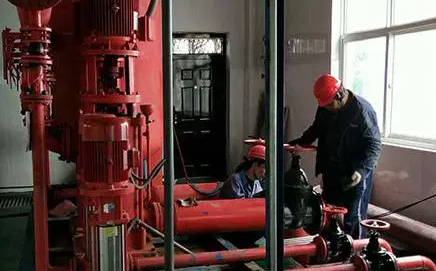Fire pump installation process and precautions
The installation of the fire pump requires the following precautions to ensure that it operates correctly, safely and effectively:
1. Preparation before installation
Check the water pump: Before installation, carefully check the integrity of the fire pump, including whether the appearance is damaged, whether the parts are damaged, etc., to ensure that the water pump is free of damage and defects.
Choose the installation location: The fire pump should be installed near the water source, such as a reservoir or a well, and choose a reasonable distance. At the same time, ensure that the installation location is away from the fire source and flammable and explosive items to reduce the risk of fire.
2. Installation process
Pipeline installation:
The weight of the pipeline should not be borne on the fire pump to avoid damaging the water pump.
The inlet and outlet pipes should have their own supports to reduce the weight of the flange.
The pipeline installation should take into account the leakage factor, minimize the occurrence of leakage, and minimize the curve of the pipeline.
For occasions with suction range, the inlet pipe end should be equipped with a foot valve, and the inlet and outlet pipes should not have too many bends, and there should be no water leakage or air leakage.
It is best to install a filter on the inlet pipe to prevent impurities from entering the impeller. The effective area of the filter should be 3 to 4 times the area of the water inlet pipe to ensure the free flow of liquid.
Fixing and support:
The anchor bolts must be tightened during installation, and the pump should be checked regularly to prevent it from loosening.
When the fire pump is installed directly, the pump can be placed on the foundation and raised by 30 to 40 mm (prepared for filling cement slurry), then corrected, and the anchor bolts are inserted, and cement mortar is filled. After the cement is completely dry, tighten the nuts of the anchor bolts.
The pump outlet pipe should be supported on the ground to avoid deformation or damage to the fire pump.
Adjustment and safety equipment:
A regulating valve should be installed on the inlet and outlet pipelines of the pump, and a pressure gauge should be installed near the pump outlet to ensure that the pump operates within the rated range.
For high-lift pumps, in order to prevent water hammer, a check valve should also be installed in front of the outlet gate valve to cope with accidents such as sudden power failure and loss of power.
The fire pump and its matching control cabinet should be reliably grounded.
Other precautions:
The fire pump should be hoisted with a stainless steel chain multi-stage fire pump bar, and it should always be placed on the pump group hoisting screws.
The outlet of the fire pump should be rigidly connected with a metal hose or steel pipe, and the length of the pipe connected to the pump outlet must extend beyond the pool cover for easy removal.

3. Post-installation inspection
Overall inspection: After installation, the entire fire pump system should be fully inspected to ensure that all components are correctly installed and securely connected.
Operation test: Before it is officially put into use, the fire pump should be tested to check whether its performance meets the requirements and ensure that it can operate normally and effectively.




